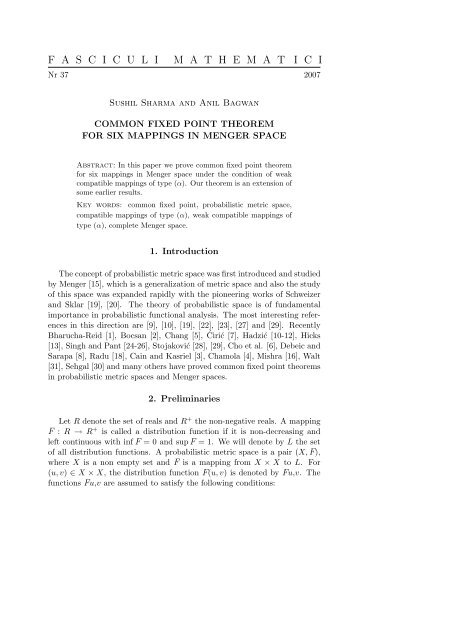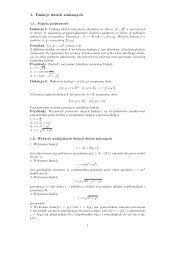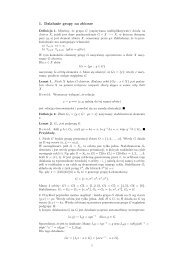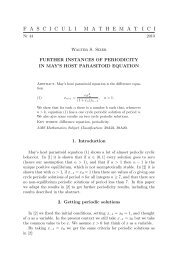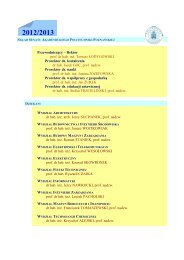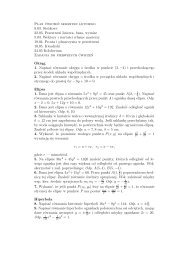F A S C I C U L I M A T H E M A T I C I
F A S C I C U L I M A T H E M A T I C I
F A S C I C U L I M A T H E M A T I C I
Create successful ePaper yourself
Turn your PDF publications into a flip-book with our unique Google optimized e-Paper software.
68 Sushil Sharma and Anil Bagwan(P 1 ) Fu,v(x) = 1 for every x > 0 if and only if u = v,(P 2 ) Fu,v(0) = 0 for every u, v ∈ X,(P 3 ) Fu,v(x) = Fu,v(x) for every u, v ∈ X,(P 4 ) if Fu,v(x) = 1 and Fv,w(y) = 1, then Fu,w(x + y) = 1for all u, v, w ∈ X and x, y > 0.In a metric space (X, d), the metric d induces a mapping F : X × X → Lsuch thatF(u, v)(x) = Fu,v(x) = H(x − d(u, v)),for every u, v ∈ X and x ∈ R, where H is a distribution function defined byH(x) ={0 , x ≤ 0 ,1 , x > 0 .Definition 2.1. A Menger space is a triple (X, F, t), where (X, F) is aPM-space and t is T -norm with the following condition:(P 5 ) Fu,w(x + y) ≥ t(Fu,v(x), Fv,w(y))for every u, v, w ∈ X and x, y ∈ R + .For topological preliminaries on a Menger space, Schweizer and Sklar [20]is an excellent reference.Definition 2.2. [18] Let (X, F, t) is a Menger space with the continuousT -norm t.(i) A sequence {p n } in X is said to be convergent to a point p ∈ X iffor every ε > 0 and λ > 0, there exists an integer N = N(ε, λ) such thatp n = ∪p(ε, λ) for all n ≥ N, or equivalently, F p , p n (ε) > 1 − λ, for alln ≥ N. We write p n → p as n → ∞ or limn→∞ p n = p.(ii) A sequence {p n } of points in X is said to be a Cauchy sequence if forevery ε > 0 and λ > 0, there exists an integer N = N(ε, λ) > 0 such thatF pn , p m (ε) > 1 − λ, for all n, m ≥ N.(iii) The Menger space (X, F, t) is said to be complete if every Cauchysequence in X is converges to a point in X.3. Weak compatible mappings of type (α)In this section we give some definitions of compatible mappings and weakcompatible mappings of type (α) on Menger space. The concept of compatiblemappings and weak compatible mappings of type (α) are equivalentunder some conditions in metric space and Menger space ([14] and [6]).
Common fixed point theorem for six mappings . . . 69Definition 3.1. Let (X, F, t) be a Menger space such that the T -norm tis continuous and A, S be mappings from X into itself. A and S are saidto be compatible iflimn→∞ FASx n, SAx n (x) = 1for all x > 0, whenever {x n } is a sequence in X such thatfor some z ∈ X.lim Ax n = lim Sx n = zn→∞ n→∞Definition 3.2. Let (X, F, t) be a Menger space such that the T -norm tis continuous and A, S be mappings from X into itself. A and S are saidto be compatible mappings of type (α) iflim FSAx n, AAx n (x) = 1 and lim FASx n, SSx n (x) = 1,n→∞ n→∞for all x > 0, whenever {x n } is a sequence in X such thatfor some z ∈ X.lim Ax n = lim Sx n = zn→∞ n→∞Definition 3.3. Let (X, F, t) be a Menger space such that the T -norm tis continuous and A, S be mappings from X into itself. A and S are saidto be weak compatible mappings of type (α) ifandlim FASx n, SSx n (x) ≥ lim FSAx n, AAx n (x)n→∞ n→∞lim FSAx n, SSx n (x) ≥ lim FASx n, AAx n (x)n→∞ n→∞for all x > 0, whenever {x n } is a sequence in X such thatfor some z ∈ X.lim Ax n = lim Sx n = zn→∞ n→∞Proposition 3.1. [14] Let (X, F, t) be a Menger space such that theT -norm t is continuous and t(x, x) ≥ x for all x ∈ [0, 1], and A, S : X → Xbe mappings. If A and S are weak compatible mappings of type (α) andAz = Sz for some z ∈ X, then AAz = ASz = SAz = SSz.Proposition 3.2. [14] Let (X, F, t) be a Meneger space such that theT -norm t is continuous and t(x, x) ≥ x for all x ∈ [0, 1], and A, S : X → X
70 Sushil Sharma and Anil Bagwanbe mappings. Let A and S be weak compatible mappings of type (α) andlim Ax n = lim Sx n = z for some z ∈ X.n→∞ n→∞Then we have(i) lim SAx n = Az, if A is continuous,n→∞(ii) lim ASx n = Sz, if S is continuous,n→∞(ii) ASz = SAz and Az = Sz, if A and S are continuous.We need the following lemmas due to Schweizer and Skalr [20] and Singhand Pant [25], in the proof of the theorems.Lemma 3.1. Let {x n } be a sequence in a Menger space (X, F, t), wheret is a continuous T -norm and t(x, x) ≥ x for all x ∈ [0, 1]. If there exists aconstant k ∈ (0, 1) such thatFx n , x n+1 (kx) ≥ Fx n−1 , x n (x)for all x > 0 and n ∈ N, the {x n } is a Chauchy sequence in X.Remark 3.1. [17] The condition ”the T -norm t is continuous and (x, x) ≥x for all x ∈ [0, 1]” can be replaced by ”t(x, y) = min{x, y} for all x, y ∈[0, 1]”. In fact, since t(a, 1) = a and t(1, b) = b for all a, b ∈ [0, 1], we havet(a, b) ≤ min{t(a, 1), t(1, b)} = min{a, b}for all a, b ∈ [0, 1]. On the other hand, we havet(a, b) ≤ t(min(a, b), min{a, b}) = min{a, b}for all a, b ∈ [0, 1], which implies t(a, b) = min{a, b}.4. Main resultTheorem 4.1. Let (X, F, t) be a complete Menger space with t(x, y) =min{x, y} for all x, y ∈ [0, 1] and A, B, S, T , P and Q be mappings fromX into itself such that(4.1) P (X) ⊂ ST (X) and Q(X) ⊂ AB(X),(4.2) P A = AP, P B = BP, AB = BA, ST = T S and QS = SQ,(4.3) the pairs {P, AB} and {Q, ST } are weak compatible of type (α),(4.4) P is continuous(4.5) [FP u, Qv(kx)] 2 ≥ min{[FABu, ST v(x)] 2 , FABu, P u(x).
Common fixed point theorem for six mappings . . . 71FST v, Qv(x), FABu, ST v(x). FABu, P u(x), FABu, ST v(x).FST v, Qv(x), FABu, ST v(x). FABu, Qv(2x), FABu, ST v(x).FST v, P u(x), FABu, Qv(2x). FST v, P u(x), FABu, P u(x).FST v, P u(x), FABu, Qv(2x). FST v, Qv(x)}for all u, v ∈ X and x ≥ 0, where k ∈ (0, 1). Then A, B, S, T , P and Qhave a unique common fixed point.Proof. For any point x 0 in X, there exists a point x 1 ∈ X, such thatP x 0 = ST x 1 . For this point x 1 , we can choose a point x 2 in X, such thatQx 1 = ABx 2 and so on, in this manner we can define a sequence {y n } inX such that y 2n = P x 2n = ST x 2n+1 and y 2n+1 = Qx 2n+1 = ABx 2n+2 , forn = 0, 1, 2, . . ..Now we shall prove Fy 2n , y 2n+1 (kx) ≥ Fy 2n−1 , y 2n (x) for all x > 0, wherek ∈ (0, 1). Suppose that Fy 2n , y 2n+1 (kx) < Fy 2n−1 , y 2n (x). Then by using(4.5) and Fy 2n , y 2n+1 (kx) ≤ Fy 2n , y 2n+1 (x), we have[Fy 2n , y 2n+1 (kx)] 2 = [FP x 2n , Qx 2n+1 (kx)] 2{≥ min [Fy 2n−1 , y 2n (x)] 2 , Fy 2n−1 , y 2n (x).Fy 2n , y 2n+1 (x),Fy 2n−1 , y 2n (x).Fy 2n−1 , y 2n (x), Fy 2n−1 , y 2n (x)Fy 2n , y 2n+1 (x),Fy 2n−1 , y 2n (x).Fy 2n−1 , y 2n+1 (2x), Fy 2n−1 , y 2n (x).Fy 2n , y 2n (x),Fy 2n−1 , y 2n+1 (2x).Fy 2n , y 2n (x), Fy 2n−1 , y 2n (x).Fy 2n , y 2n (x),Fy 2n−1 , y 2n+1 (2x).Fy 2n , y 2n+1 (x)}{≥ min [Fy 2n−1 , y 2n (x)] 2 , Fy 2n−1 , y 2n (x).Fy 2n , y 2n+1 (x),[Fy 2n−1 , y 2n (x)] 2 , Fy 2n−1 , y 2n (x).Fy 2n , y 2n+1 (x),Fy 2n−1 , y 2n (x).t (Fy 2n−1 , y 2n (x), Fy 2n , y 2n+1 (x)) , Fy 2n−1 , y 2n (x),t (Fy 2n−1 , y 2n (x), Fy 2n , y 2n+1 (x)) , Fy 2n−1 , y 2n (x),t (Fy 2n−1 , y 2n (x), Fy 2n , y 2n+1 (x)) , Fy 2n , y 2n+1 (x)}{≥ min [Fy 2n , y 2n+1 (kx)] 2 , [Fy 2n , y 2n+1 (kx)] 2 , [Fy 2n , y 2n+1 (kx)] 2 ,[Fy 2n , y 2n+1 (kx)] 2 , [Fy 2n , y 2n+1 (kx)] 2 , Fy 2n , y 2n+1 (kx),Fy 2n , y 2n+1 (kx), Fy 2n , y 2n+1 (kx), [Fy 2n , y 2n+1 (kx)] 2= [Fy 2n , y 2n+1 (kx)] 2}which is a contradiction. Thus we haveFy 2n , y 2n+1 (kx) ≥ Fy 2n−1 , y 2n (x).
72 Sushil Sharma and Anil BagwanSimilarly we can have Fy 2n+1 , y 2n+2 (kx) ≥ Fy 2n , y 2n+1 (x). Therefore, forevery n ∈ N,Fy n , y n+1 (kx) ≥ Fy n−1 , y n (x).Therefore by Lemma 3.1, {y n } is a Cauchy sequence in X. Since the Mengerspace (X, F, t) is complete, {y n } converges to a point z in X, and thesubsequences {P x 2n }, {Qx 2n+1 }, {ABx 2n } and {ST x 2n+1 } of {y 2n } alsoconverges to z.Now suppose that P is continuous, since P and AB are weak compatibleof type (α), it follows from(AB)P x 2n → P z and P P x 2n → P z as n → ∞.Now putting u = P x 2n and v = x 2n+1 in the equation (4.5), we have[FP P x 2n , Qx 2n+1 (kx)] 2 ≥ min { [F(AB)P x 2n , ST x 2n+1 (x)] 2 ,F(AB)P x 2n , P P x 2n (x).FST x 2n+1 , Qx 2n+1 (x),F(AB)P x 2n , ST x 2n+1 (x). F(AB)P x 2n , P P x 2n (x),F(AB)P x 2n , ST x 2n+1 (x). FST P x 2n+1 , Qx 2n+1 (x),F(AB)P x 2n , ST x 2n+1 (x). F(AB)P x 2n , Qx 2n+1 (2x),F(AB)P x 2n , ST x 2n+1 (x). FST x 2n+1 , P P x 2n (x),F(AB)P x 2n , Qx 2n+1 (2x). FST x 2n+1 , P P x 2n (x),F(AB)P x 2n , P P x 2n (x). FST x 2n+1 , P P x 2n (x),F(AB)P x 2n , Qx 2n+1 (2x). FST x 2n+1 , Qx 2n+1 (x)} .Taking the limit n → ∞, we have[FP z,z(kx)] 2 ≥ min { [FP z,z(x)] 2 , FP z,P z(x)] 2 . Fz,z(x),FP z,z(x). FP z,P z(x), FP z,z(x). Fz,z(x),FP z,z(x). FP z,z(2x), FP z,z(x). Fz,P z(x),FP z,z(2x). Fz,P z(x), FP z,P z(x). Fz,P z(x),FP z,z(2x). Fz,z(x)} = [FP z,z(x)] 2which is a contradiction. Thus we have P z = z. Since P (X) ⊂ ST (X), thereexists a point u ∈ X such that z = P z = ST p. Again putting u = P x 2n
Common fixed point theorem for six mappings . . . 73and v = p in (4.5), we have[FP P x 2n , Qp(kx)] 2 ≥ min { [F(AB)P x 2n , ST p(x)] 2 ,F(AB)P x 2n , P P x 2n (x).FST p, Qp(x), F(AB)P x 2n , ST p(x). F(AB)P x 2n , P P x 2n (x),F(AB)P x 2n , ST p(x). FST p, Qp(x), F(AB)P x 2n , ST p(x).F(AB)P x 2n , Qp(2x), F(AB)P x 2n , ST p(x). FST p, P P x 2n (x),F(AB)P x 2n , Qp(2x). FST p, P P x 2n (x), F(AB)P x 2n , P P x 2n (x).FST p, P P x 2n , F(AB)P x 2n , Qp(2x). FST p, Qp(x)} .Taking the limit n → ∞, we have[Fz, Qp(kx)] 2 ≥ [Fz, Qp(x)] 2which is a contradiction, therefore z = Qp. Since Q and ST are weakcompatible of type (α) and ST p = Qp = z, by Proposition 3.1, (ST )Qp =Q(ST )p and hence ST z = (ST )Qp = Q(ST )p = Qz. Again by puttingu = x 2n and v = z in (4.5), we have[FP x 2n , Qz(kx)] 2Letting n → ∞, we have≥ min { [FABx 2n , ST z(x)] 2 , FABx 2n , P x 2n (x).FST z, Qz(x), FABx 2n , ST z(x). FABx 2n , P x 2n (x),FABx 2n , ST z(x). FST z, Qz(x), FABx 2n , ST z(x).FABx 2n , Qz(2x), FABx 2n , ST z(x). FST z, P x 2n (x),FABx 2n , Qz(2x). FST z, P x 2n (x), FABx 2n , P x 2n (x).FST z, P x 2n , FABx 2n , Qz(2x). FST z, Qz(x)} .[Fz, Qz(kx)] 2 ≥ [Fz, Qz(x)] 2which is a contradiction, therefore we have Qz = z. Thus Qz = ST z = z.Similarly since P and AB are weak compatible of type (α) and by Proposition3.1, we have ABz = P z = z. Now we prove Az = z. Suppose thatAz ≠ z then by putting u = Az and v = z in (4.5), we have[FP Az, Qz(kx)] 2≥ min { [F(AB)Az, ST z(x)] 2 , F(AB)Az, P Az(x).FST z, Qz(x), F(AB)Az, ST z(x). F(AB)Az, P Az(x),F(AB)Az, ST z(x). FST z, Qz(x), F(AB)Az, ST z(x).F(AB)Az, Qz(2x), F(AB)Az, ST z(x). FST z, P Az(x),F(AB)Az, Qz(2x). FST z, P Az(x), F(AB)Az, P Az(x).FST z, P Az(x), F(AB)Az, Qz(2x). FST z, Qz(x)}
Common fixed point theorem for six mappings . . . 75If we put B = T = I (I is identity mapping on X) in Theorem 4.1., weobtain the following result due to Pathak et al. [17].Corollary 4.1. Let (X, F, t) be a complete Menger space with t(x, y) =min{x, y} for all x, y ∈ [0, 1] and P , Q, A and S be mappings from X intoitself such that(4.6) P (X) ⊂ S(X) and Q(X) ⊂ A(X),(4.7) the pairs {P, A} and {Q, S} are weak compatible of type (α)(4.8) P is continuous,(4.9) [FP u, Qv(kx)] 2 ≥ min { FAu, Sv(x)] 2 , FAu, P u(x). FSv, Qv(x),FAu, Sv(x). FAu, P u(x), FAu, Sv(x).FSv, Qv(x), FAu, Sv(x). FAu, Qv(2x), FAu, Sv(x).FSv, P u(x), FAu, Qv(2x). FSv, P u(x), FAu, P u(x).FSv, P u(x), FAu, Qv(2x). FSv, Qv(x)}for all u, v ∈ X and x ≥ 0, where k ∈ (0, 1). Then P , Q, A and S have aunique common fixed point.If we put A = B = S = T = I (I is identity mapping on X) in Theorem4.1, we have the following:Corollary 4.2. Let (X, F, t) be a complete Menger space with t(x, y) =min{x, y} for all x, y ∈ [0, 1] and P and Q be mappings from X into itselfsuch that(4.10) P (X) ⊂ Q(X),(4.11) P is continuous,(4.12) [FP u, Qv(kx)] 2 ≥ min { Fu, v(x)] 2 , Fu, P u(x). Fv, Qv(x),Fu, v(x). Fu, P u(x), Fu, v(x). Fv, Qv(x)Fu, v(x). Fu, Qv(2x), Fu, v(x). Fv, P u(x),Fu, Qv(2x). Fv, P u(x), Fu, P u(x). Fv, P u(x),Fu, Qv(2x), Fv, Qv(x)}for all u, v ∈ X and x ≥ 0, where k ∈ (0, 1). Then P and Q have a uniquecommon fixed point.
76 Sushil Sharma and Anil BagwanReferences[1] Bharucha-Reid A.T., Fixed point theorems in probabilistic analysis, Bull.Amer. Math. Soc., 82(1976), 641–657.[2] Bocsan G., On some fixed point theorems in probabilistic metric spaces,Math. Balkanica, 4(1974), 67–70.[3] Cain G.L., Kasriel R.H., Fixed and periodic points of local contractionmappings on probabilistic metric spaces, Math. System Theory, 9(1976),289–297.[4] Chamola K.P., Fixed points of mappings satisfying a new contraction conditionin Random Normed spaces, Math. Japonica, 33(1988), 821–825.[5] Chang S.S., On some fixed point theorems in probabilistic metric spaces andits application, Z. Wahrsch. Verw. Gebiete, 63(1983), 463–474.[6] Cho Y.J., Murthy P.P., Stojakovic M., Compatible mappings of type(A) and common fixed points in Meneger spaces, Comm. of Karean Math. J.,7(1992), 325–339.[7] Ciric L.B., On fixed points of generalized contractions on probabilistic metricspaces, Publ. Inst. Math. Beograd, 18(32)(1975), 71–78.[8] Debeic R., Sarapa N., A common fixed point theorem for three mappingson Meneger spaces, Math. Japonica, 34(1989), 919–923.[9] Egbert R.J., Products and quotients of probabilitic metric space, Pacific J.Math., 24(1968), 437–455.[10] Hadzic O., On the (ε, λ) topology of LPC-space, Glasnik Math., 13(1978),293–297.[11] Hadzic O., A fixed point theorem in probabilistic localy convex spaces, Rev.Roum. Math. Pures Appl., 23(1978), 735–744.[12] Hadzic O., Some theorems on the fixed point in probabilistic metric spaceand Random normed spaces, Ball. Un. Mat. Ital., 13(5)18(1981), 1–11.[13] Hicks T.L., Fixed point theory in probabilistic metric spaces, Review ofResearch, Fasc. Sci Math. Series, Univ. of Novi. Sad, 13(1983), 63–72.[14] Jungck G., Murthy P.P., Cho Y.J, Compatible mappings ot type (A)and common fixed points, Math. Japonica, 38(1983), 381–390.[15] Menger K., Statistical metric, Proc. Nat. Acad. Sci. U.S.A, 28(1942),535–537.[16] Mishra S.N., Common fixed point of compatible mappings in probabilisticmetric space, Math. Japonica, 36(1991), 283–289.[17] Pathak H.K., Kang S.M., J.H. Beak, Weak compatible mppings of type(A) and common fixed points in Meneger spaces, Comm. Korean Math. Soc.,10(1)(1995), 67–83.[18] Radu V., On some contraction type mappings in Menger space, An. Univ.Timisora, Stiinte Math., 22(1-2)(1984), 83–88.[19] Schweizer B., Sklar A., Statistical metric space, Pacific J. Math.,10(1960), 313–334.[20] Schweizer B., Sklar A., Probabilistic metric space, Vol. 5, North–Hollandseries in probability and Applied Math., 1983.[21] Serstnev A.N., The notion of the Random normed space, Dolk. Akad. Nauk.USSR, 149(1963), 280–283.
Common fixed point theorem for six mappings . . . 77[22] Sherwood H., On the completion of probabilistic metric space, Z. Wahrsch.Verw. Gebiete, 6(1966), 62–64.[23] Sherwood H., Complete probabilistic metric space, Z. Wahrsch. Verw. Gebiete,20(1971), 117–128.[24] Singh S.L., Pant B.D., Fixed point theorems for commuting mappings inprobabilistic metric space, Honam Math. J., 5(1983), 139–150.[25] Singh S.L., Pant B.D., Common fixed point theorems in probabilistic metricspaces and extension to uniform spaces, Honam Math. J. Phy., 6(1984), 1–12.[26] Singh S.L., Pant B.D., Concidence and fixed point theorems for a family ofmappings on Menger space and extension of Uniform space, Math. Japonica,33(1988), 957–973.[27] Spacek A., Note on K. Meneger probabilistic geometry, Czechoslovak Math.J., 6(1956), 72–74.[28] Stojakovic M., Fixed point theorem in probabilistic metric space, Kobe J.Math., 2(1985), 1–9.[29] Stojakovic M., A common fixed point theorems in probabilistic metric spaceand its application, Glasnik Math., 23(1988), 203–211.[30] Sehgal V.M., Bharuch-Read A.T., Fixed point of contraction mappingson probabilistics metric spaces, Math. Systems Theory, 6(1972), 72–102.[31] Wald A., A on a statistical generalization of metric space, Proc. Nat. Acad.Sci. U.S.A., 29(1943), 196–197.Anil BagwanDepartment of Mathematics and Computer ScienceMadhav Science CollegeUjjain (M.P.)-456010, Indiae-mail: anil bagwan2000@yahoo.co.inSushil SharmaDepartment of Mathematics, Madhav Vigyam MahavidyalayaVikram University, Ujjain-45600, Indiae-mail: sksharma2005@yahoo.comReceived on 07.03.2001 and, in revised form, on 25.10.2004.


